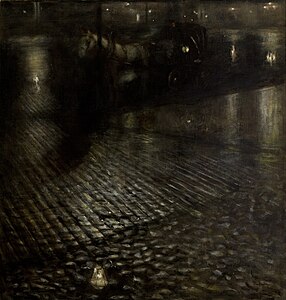Józef Pankiewicz


Józef Pankiewicz (29 November 1866, in Lublin – 4 July 1940, in La Ciotat) was a Polish impressionist painter, graphic artist and teacher who spent much of his career in France.
Biography
From 1884 to 1885, he studied at the School of Fine Arts in Warsaw under Wojciech Gerson and Aleksander Kamiński. After obtaining a scholarship, he went to Saint Petersburg to study at the Imperial Academy of Arts.[1] In 1889, he and his studio partner Władysław Podkowiński went to Paris to participate in the Exposition Universelle and he was awarded a silver medal for his painting of a vegetable market.[2]
While there, he was influenced by the impressionists and, when he returned to Poland in 1890, attempted to introduce the latest French trends there. The reaction from critics was largely hostile; one going so far as to advise him to see an optometrist. He persisted, however, and later produced a series of portraits inspired by the work of James McNeill Whistler. His portrait, "Mrs. Oderfeld and her Daughter", won a gold medal at the Exposition Universelle (1900).[2] He was also a frequent exhibitor at the Salon.
In 1897, he became one of the founding members of the Society of Polish Artists "Sztuka". For the next nine years, he travelled continuously throughout Western Europe, until he was appointed a Professor at the Kraków Academy of Fine Arts in 1906.[1] He continued to travel in France, especially along the Mediterranean coast, producing a large series of landscapes and city views which increasingly showed the influence of Paul Cézanne.
During the First World War, he lived in Spain, where he met
Between the wars, his style evolved again, becoming more decorative, and he painted a series of
Selected paintings
-
Rue Cardinale, Paris
-
Cab at Night
-
Haystacks, National Museum in Kielce
-
Woman Brushing her Hair
References
- ^ a b c Biographical notes @ Agra Art.
- ^ a b c Brief biography and appreciation @ Culture.pl
- ^ Documentation @ the Base Léonore.
Further reading
- Janusz Janowski, "Józef Pankiewicz wobec „łacińskiej tradycji” malarstwa europejskiego" (Pankiewicz and the "Latin Tradition" in European painting), Pamiętnik Sztuk Pięknych, Nicolaus Copernicus University in Toruń, #1(4), 2003
- Elżbieta Charazińska (ed.), Józef Pankiewicz 1866-1940. Życie i dzieło. (exhibition catalog) ISBN 83-7100-335-8
- Stefania Krzysztofowicz-Kozakowska, Józef Pankiewicz, "Mistrzowie malarstwa polskiego" series, Kluszczyński, 1996 ISBN 83-86328-64-9




